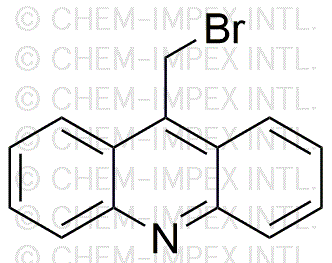9-(Bromomethyl)acridine is widely utilized in research focused on:
- Anticancer Research: This compound is being explored for its potential as a chemotherapeutic agent, particularly in targeting specific cancer cell lines due to its ability to intercalate DNA.
- Fluorescent Probes: It serves as a fluorescent marker in biological imaging, helping researchers visualize cellular processes in real-time, which is crucial for understanding disease mechanisms.
- Organic Synthesis: The compound is used as an intermediate in the synthesis of various organic molecules, providing a pathway for creating complex chemical structures in pharmaceuticals.
- Material Science: It finds applications in developing new materials with unique optical properties, which can be beneficial in electronics and photonics industries.
- Bioconjugation: The bromomethyl group allows for easy conjugation with biomolecules, making it useful in creating targeted drug delivery systems and improving therapeutic efficacy.
General Information
Properties
Safety and Regulations
Applications
9-(Bromomethyl)acridine is widely utilized in research focused on:
- Anticancer Research: This compound is being explored for its potential as a chemotherapeutic agent, particularly in targeting specific cancer cell lines due to its ability to intercalate DNA.
- Fluorescent Probes: It serves as a fluorescent marker in biological imaging, helping researchers visualize cellular processes in real-time, which is crucial for understanding disease mechanisms.
- Organic Synthesis: The compound is used as an intermediate in the synthesis of various organic molecules, providing a pathway for creating complex chemical structures in pharmaceuticals.
- Material Science: It finds applications in developing new materials with unique optical properties, which can be beneficial in electronics and photonics industries.
- Bioconjugation: The bromomethyl group allows for easy conjugation with biomolecules, making it useful in creating targeted drug delivery systems and improving therapeutic efficacy.
Documents
Safety Data Sheets (SDS)
The SDS provides comprehensive safety information on handling, storage, and disposal of the product.
Product Specification (PS)
The PS provides a comprehensive breakdown of the product’s properties, including chemical composition, physical state, purity, and storage requirements. It also details acceptable quality ranges and the product's intended applications.
Certificates of Analysis (COA)
Search for Certificates of Analysis (COA) by entering the products Lot Number. Lot and Batch Numbers can be found on a product’s label following the words ‘Lot’ or ‘Batch’.
*Catalog Number
*Lot Number
Certificates Of Origin (COO)
This COO confirms the country where the product was manufactured, and also details the materials and components used in it and whether it is derived from natural, synthetic, or other specific sources. This certificate may be required for customs, trade, and regulatory compliance.
*Catalog Number
*Lot Number
Safety Data Sheets (SDS)
The SDS provides comprehensive safety information on handling, storage, and disposal of the product.
DownloadProduct Specification (PS)
The PS provides a comprehensive breakdown of the product’s properties, including chemical composition, physical state, purity, and storage requirements. It also details acceptable quality ranges and the product's intended applications.
DownloadCertificates of Analysis (COA)
Search for Certificates of Analysis (COA) by entering the products Lot Number. Lot and Batch Numbers can be found on a product’s label following the words ‘Lot’ or ‘Batch’.
*Catalog Number
*Lot Number
Certificates Of Origin (COO)
This COO confirms the country where the product was manufactured, and also details the materials and components used in it and whether it is derived from natural, synthetic, or other specific sources. This certificate may be required for customs, trade, and regulatory compliance.


